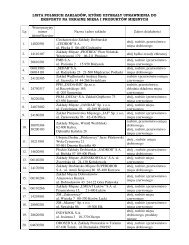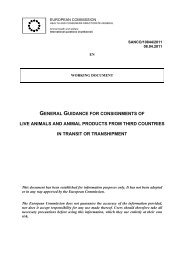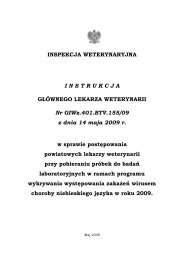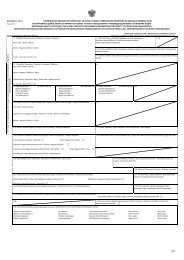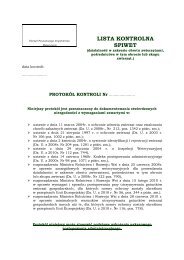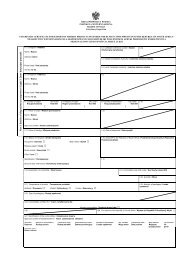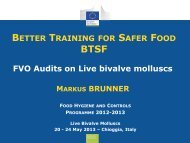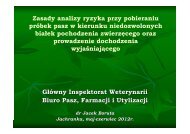Captive bolt gun t i stunning
Captive bolt gun t i stunning
Captive bolt gun t i stunning
- No tags were found...
You also want an ePaper? Increase the reach of your titles
YUMPU automatically turns print PDFs into web optimized ePapers that Google loves.
<strong>Captive</strong> <strong>bolt</strong> <strong>gun</strong><br />
<strong>stunning</strong><br />
Bo Algers<br />
Swedish University of Agricultural Sciences
I wish to acknowledge<br />
my PhD student Sophie Atkinson who<br />
did most of the studies presented here.
The placement of the weapon on cattle:
Placement of the weapon, sheep and goat without horns:<br />
Placement, sheep and goat with horns:<br />
OBS! Shorter stun-to-stick:<br />
15 sek!
Stun should cause immediate unconsciousness
Background<br />
• The Swedish regulation requires sticking<br />
within 60 seconds after stun (cattle & pigs).<br />
• Industry wanted extensions of this time;<br />
(If stun quality was good – could stun to<br />
stick intervals be extended)<br />
- development of stun quality audits.
Objectives<br />
• Monitor the stun to stick intervals times<br />
• Assess the stun quality<br />
- 100 bulls & 100 other cattle classes<br />
(per audit)
shooter<br />
Stunbox<br />
Stun crate<br />
Stun effect observation<br />
Back leg shackling<br />
2 m<br />
2 m<br />
3 m<br />
3 m<br />
sticking<br />
sticking<br />
Stun to stick was timed<br />
- Started when shot was heard<br />
- Stopped when knife thrust into throat
Results<br />
Stun to stick intervals<br />
• 5% of the cattle were stuck within 60<br />
seconds
Stun Quality<br />
Good stun<br />
Poor Stun<br />
Undefined<br />
Symptoms<br />
- dilated pupils<br />
- no eyeball rotation<br />
ti<br />
- no corneal reflex<br />
- minimal reaction to sticking<br />
- corneal reflex<br />
- spontaneous blinking<br />
- breathing/respirations<br />
- fixed eyeball rotation ti to stick<br />
- gasping, groaning<br />
- excessive struggling at stick<br />
(with no other symptoms)
Stun quality results cattle<br />
% Poor stuns<br />
Abattoir Cows Bulls Both<br />
1( (c) 36 3.6 15 10<br />
Uneven edge on <strong>bolt</strong><br />
1 (c) 3 15 7.2<br />
1(c) 13 1.3 13 63 6.3<br />
2 (c) 0 28 16.6<br />
2(p) 0.3 1.7 0.6<br />
3 (c) 0.7 16.3 6.7<br />
4 (c) 0 13 4<br />
5 (c) 1.3 5.8 3.7<br />
Total 1.4%<br />
A<br />
13.5%<br />
6.8%<br />
(n= 1552) n=1250 (n = 2802)<br />
Damp amunition<br />
Pnuematic stunner<br />
c= captive <strong>bolt</strong><br />
p = pneumatic stunner
Pneumatic <strong>bolt</strong> stunner
E<br />
B<br />
A<br />
C<br />
D
%of animal class showing poor stun symptoms shot in skull area A<br />
Bulls<br />
91% Cow s<br />
8%<br />
Steers<br />
1%<br />
* Total amount showing poor stun 10%
Percent of each cattle class reshot<br />
Pe ercentage e<br />
20<br />
18<br />
16<br />
14<br />
12<br />
10<br />
8<br />
6<br />
4<br />
2<br />
0<br />
97/585<br />
20/306<br />
3/58<br />
4/49<br />
Bulls Cows Steers Calves<br />
Animal class
Percent of cattle class with poor stun quality all audits<br />
%<br />
16<br />
14<br />
12<br />
10<br />
8<br />
6<br />
4<br />
2<br />
0<br />
13,6<br />
1,4<br />
Bulls<br />
(n=1250)<br />
cows,heifers,strs,calves<br />
, ,<br />
(n=1552)
Conclusions<br />
This audit system provided a valuable tool<br />
for assessing & improving<br />
welfare of animals at slaughter<br />
Stunning large cattle with a captive <strong>bolt</strong> <strong>gun</strong><br />
may result in a large proportion of animals not<br />
being properly stun.
Stun quality in relation to cattle size,<br />
<strong>gun</strong> type and brain haemorrhages
Objectives:<br />
Examine, in depth, the causes behind poor stun<br />
quality in cattle, especially large animals.<br />
594 cattle in two abattoirs (A and B) were observed<br />
by assessing stun quality. 14 of those were examined<br />
macroscopically for brain haemorrhages.
A captive <strong>gun</strong> <strong>bolt</strong> (abattoir A and B) and a pneumatic <strong>bolt</strong> (B)<br />
were used.<br />
The firing velocity and energy values were for the 0.22<br />
calibre <strong>gun</strong> <strong>bolt</strong>:<br />
Black cartridges - 66.8 m/s and 517 joules<br />
Rd Red cartridges tid - 56.4 m/s and 361 joules<br />
Specifications for the pneumatic <strong>bolt</strong> were;<br />
Operating pressure 11-12 bar<br />
Air consumption per cycle<br />
41 L<br />
Penetrating <strong>bolt</strong> diameter 15.9 mm
: Displayed signs grouped and rated from 1 - 4<br />
Rating<br />
1<br />
2<br />
3<br />
Signs displayed<br />
•Corneal reflex<br />
•Spontaneous blinking<br />
•Full or partial eyeball rotation up to sticking<br />
•Full or partial eye ball rotation followed by pupil<br />
dilation i before sticking<br />
4 •Gasping, groaning<br />
•Excessive struggling or kicking at sticking
Frequency of signs rated 1 or 2 in abattoir A<br />
and B.<br />
Abattoir Gun type Sign ratings 1& 2<br />
Cows<br />
(n=400)<br />
Bulls<br />
(n=194)<br />
A Gun Bolt 30% 3.0% 15.0%<br />
B Gun Bolt 0.0% 28.0%<br />
B Pneumatic Bolt 0.3% 1.7%
Effect of <strong>bolt</strong> velocity and diameter of a captive <strong>bolt</strong> <strong>gun</strong> on energy transfer (joule),<br />
To the animal´s head and the presence of Visual‐Evoked Responses in the brain<br />
(Gregory and Shaw, 2000)<br />
Bolt velocity (m/sec ‐1 )<br />
47 55<br />
Bolt diameter Energy VER Energy VER<br />
(mm) transfer transfer<br />
12 97+17 3/6 124+25 1/8<br />
14 125+18 2/8 139+25 1/8<br />
16 158+20 1/7 186+30 0/7<br />
VER´ s were measured as an index of brain function<br />
by way of electrocorticograms taken from electrodes planted into the<br />
brains of the cattle. The electrical wave values given indicate the brains<br />
ability to respond to external stimulus, which in this case were light<br />
flashes from a source 1 meter in front of the animal’s eyes.
Phineas Gage (1823-1860), railroad<br />
construction foreman in Vermont, USA,<br />
got 1848 this rod through his head,<br />
survived but had severe changes in<br />
his personality.<br />
After a couple of minutes he<br />
was able to talk and then<br />
walk to a carriage in which<br />
he in sitting position traveled<br />
a few kilometers to get medical<br />
assistance.
Brain damage on captive <strong>bolt</strong> shot bull showing<br />
signs of good <strong>stunning</strong>.
Blood haemorrhages in the range of 25-50% after<br />
Blood haemorrhages in the range of 25 50% after<br />
captive <strong>bolt</strong> <strong>stunning</strong> with poor stun quality.
E<br />
B<br />
A<br />
C<br />
D<br />
Recommended area, A,<br />
for placing the <strong>bolt</strong><br />
in a 90 degree angel.
Cartridge <strong>bolt</strong> shot bull<br />
shot 3 times.<br />
Pneumatic <strong>bolt</strong> shot bull<br />
shot once.
Bleeding in brain cavity of a bull<br />
shot with captive <strong>bolt</strong> and which<br />
showed signs of poor <strong>stunning</strong>.<br />
Bleeding in brain cavity of a bull<br />
shot with a captive <strong>bolt</strong> and which<br />
showed signs of good <strong>stunning</strong>.
: Displayed signs grouped and rated from 1 - 4<br />
Rating<br />
1<br />
2<br />
3<br />
Signs displayed<br />
•Corneal reflex<br />
•Spontaneous blinking<br />
•Full or partial eyeball rotation up to sticking<br />
•Full or partial eye ball rotation followed by pupil<br />
dilation i before sticking<br />
4 •Gasping, groaning<br />
•Excessive struggling or kicking at sticking
Reflex symptoms & related brain bleedings damage around level the brain stem<br />
11<br />
. cattle<br />
No<br />
10<br />
9<br />
8<br />
7<br />
6<br />
5<br />
reflex rate 0<br />
Reflex rate 4<br />
Reflex rate 3<br />
Reflex rate 2<br />
Reflex rate 1<br />
4<br />
3<br />
2<br />
1<br />
0<br />
Major brain<br />
stem bleedings<br />
Minor brain<br />
stem bleedings
Normal shot<br />
angle<br />
Shot angle that t would optimize i damages<br />
to brain stem area<br />
The brain damages seen by the pneumatic <strong>bolt</strong> tended to be larger,<br />
with more and heavier bleeding areas at the back of the brain.<br />
This suggests that the brain is shaken more vigorously with the<br />
pneumatic <strong>bolt</strong> at shooting, contributing to higher stun quality.<br />
Bleedings on the brain as a result of a hit, tend to occur on the<br />
opposite part of the brain where the impact occurred (“contre-coup”<br />
-effect).<br />
To create a rapid and massive bleeding it is favourable to cause an<br />
arterial bleeding in the subdural or subarachnoidal areas around the<br />
brain stem and basal parts of the brain.
Conclusions:<br />
Heavy blood haemorrhage or even brain matter disintegration<br />
in the frontal regions of the brain, does not necessarily indicate<br />
certain unconsciousness or insensitivity to pain.<br />
However, if there are arterial bleedings around the brain stem,<br />
even if small, and subarachnoid haemorrhaging at the base<br />
of the brain, there will be definite, rapidly commencing<br />
state of unconsciousness and a high probability of death.
45<br />
CNR<br />
40<br />
PSCR<br />
35<br />
PSR<br />
% Anim als<br />
30<br />
25<br />
20<br />
15<br />
CNR<br />
CNR<br />
CNR<br />
10<br />
5<br />
0<br />
PSCR<br />
PSR<br />
PSCR<br />
PSR<br />
PSCR<br />
PSR<br />
Bulls<br />
Cows, steers,<br />
calves<br />
All cattle<br />
Cattle category
Conclusions:<br />
A penetrating <strong>bolt</strong> stunner should have enough power,<br />
but further investigations are needed to assess which is<br />
the proper direction of the <strong>bolt</strong> <strong>gun</strong>, in particular in large<br />
animals, in order to obtain arterial bleedings around the<br />
brain stem and at the base of the brain.
I don´t want to<br />
hear no more!!





